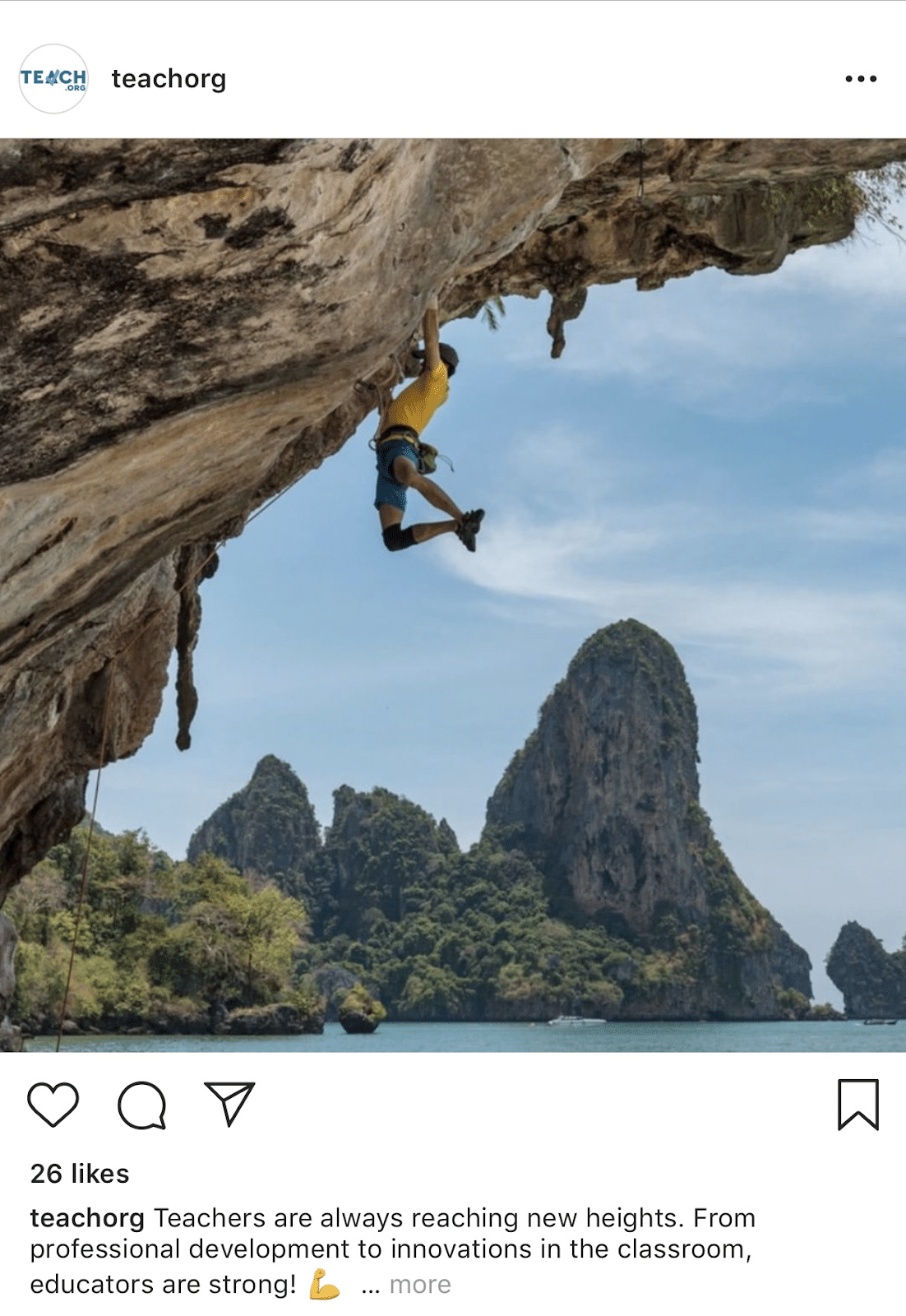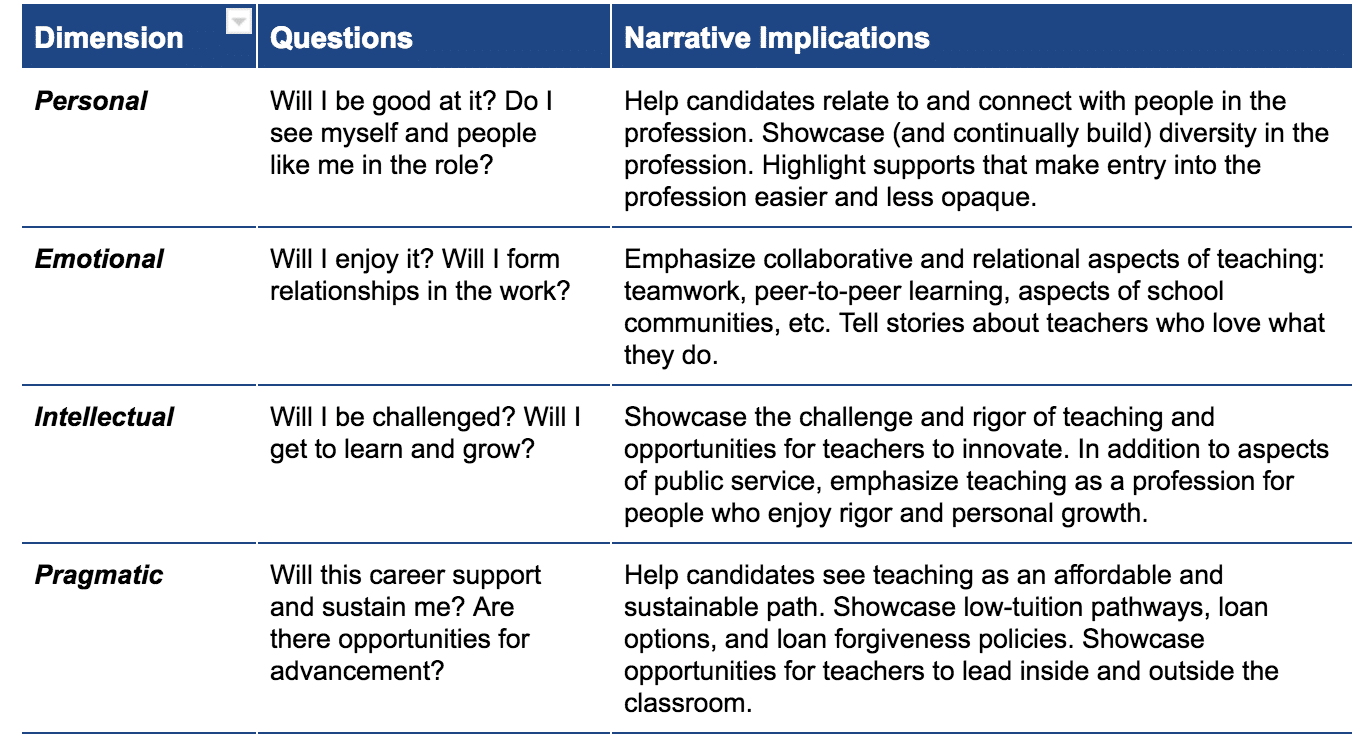VOICES – Jennifer Kabaker on Changing the Narrative and Recruiting Lifelong Educators
CompetencyWorks Blog
 This is the eighth post in a ten-part series that aims to make concepts, themes, and strategies described in the Moving Toward Mastery: Growing, Developing, and Sustaining Educators for Competency-Based Education report accessible and transferable. Links to the other articles in the series are at the end of this post.
This is the eighth post in a ten-part series that aims to make concepts, themes, and strategies described in the Moving Toward Mastery: Growing, Developing, and Sustaining Educators for Competency-Based Education report accessible and transferable. Links to the other articles in the series are at the end of this post.
How can we recruit and retain lifelong educators who will learn, improve, and lead over the course of their careers? This of course is a question for the entire field of education, not just for competency-based education. But I think it is a particularly important question for competency-based districts and schools to grapple with because becoming a competency-based educator is a continuous process of personal mastery. You don’t become masterful overnight; it takes time.
Moving Toward Mastery touches on this question in two sections: diversifying pathways into the profession and diversifying pathways through the profession. Essentially, the paper says that states, districts, and schools share responsibility for (1) creating recruitment, preparation, and placement pathways that meet teacher workforce needs and ensure diversity; (2) connecting these early stages of a teacher’s professional pathway to their ongoing learning, development, and advancement; and (3) creating opportunities for teachers to grow and lead in their careers so that they stay in the teaching profession.
These ideas can seem far away and unreachable. To bring them closer into view, I thought it would be useful to highlight a leader and organization working to create pathways into teaching, and crafting a narrative about teaching as a lifelong profession. This post highlights the voice and work of Jennifer Kabaker and the team at TEACH.
Background
TEACH is a nonprofit organization working to ensure that there is a great teacher in every classroom. They approach this goal by crafting a new narrative about teaching that excites and motivates candidates. They also demystify and streamline pathways into the profession using online tools and services to support prospective teachers as they explore the profession, and they partner with regions to create diverse and sustainable teacher pipelines.
 Jennifer Kabaker is Chief of Staff and Director of Growth at TEACH. Explaining her choice to join TEACH, she says “I spent the last four years of my career thinking about developing a new system of currency for professional learning — exploring ways to give teachers agency and opportunities for meaningful growth. It occurs to me that a big part of that has to involve getting the right people into the classroom in the first place. How can we build a workforce that is hungry for these opportunities? I have spent time rewriting the narrative about what it is to teach and what it looks like to grow as a teacher. Now I am focused on telling that same story.”
Jennifer Kabaker is Chief of Staff and Director of Growth at TEACH. Explaining her choice to join TEACH, she says “I spent the last four years of my career thinking about developing a new system of currency for professional learning — exploring ways to give teachers agency and opportunities for meaningful growth. It occurs to me that a big part of that has to involve getting the right people into the classroom in the first place. How can we build a workforce that is hungry for these opportunities? I have spent time rewriting the narrative about what it is to teach and what it looks like to grow as a teacher. Now I am focused on telling that same story.”
Jennifer and I discussed three big issues related to professional pathways: crafting a new narrative about teaching, streamlining pathways into teaching, and developing regional strategies to build and grow a sustainable teacher workforce.
To recruit career educators, craft a new narrative about teaching (and create the right conditions). TEACH believes that part of recruiting career teachers is changing the way prospective teachers think about the profession. Common messages about teaching focus on aspects of service, but TEACH’s research suggests that these messages may not address the questions prospective teachers have about the profession. Jennifer explains the four dimensions of teaching that Teach has found to be most influential in shaping candidates’ perceptions of teaching, and uses related messages to craft social media campaigns, online supports, and targeted communications strategies in focal regions.

Jennifer and I talked candidly about whether or not these conditions are always actually present for teachers. Jennifer believes that yes, for the most part, they are. Many of candidates’ concerns — expense, isolation, and others — can be addressed with better information about incentives, supports, and opportunities that exist in most states.
In some cases, of course, teaching conditions do not yet reflect this picture. Diversity is not always represented. Credentialing can be confusing. Pay is not always competitive. Still, I find Jennifer’s perspective hopeful: to start building the workforce we want and need, let’s help prospective teachers see what is working and what is exciting about teaching today.
To recruit career educators, streamline and simplify pathways into the profession. Up to sixty percent of educators who start preparation programs do not finish, often because of unintended barriers. TEACH addresses this by allowing prospective teachers to create personalized, dynamic, and simple “roadmaps” into the profession. Roadmaps do several things: they identify preparation programs and credentialing requirements based on a candidate’s location, they help candidates explore local roles and positions based on fit with interests, and they provide personalized resources and information based on the questions or priorities a candidate identifies. Part of a TEACH roadmap is shown below.

I think the big idea here is simple: getting into teaching can seem daunting, but it can be easier when someone (TEACH, or a state, or a district, or YOU) adopt a “user experience” lens to making the process more transparent, more personal, and simpler.
To recruit career teachers, regions can engage in focused collaboration to create sustainable pipelines. The US faces persistent teacher shortages. Some signs suggest that shortages are getting worse, including recent shortages in elementary school teachers. Depending on the region, shortages may be particularly great in specific areas; common shortage areas include special education and dual language teachers. In addition, many regions seek to increase the number of teachers of color who reflect the identities of the students they serve. A region may be a city, state, preparation program, school system, or an area supported by a partner such as TEACH.
TEACH currently supports four regions (Connecticut, Dallas-Fort Worth, Houston, and Kansas City) in their efforts to anticipate, address, and prevent teacher shortages. In each region Teach works with a “harbormaster” organization (a hub organization) that convenes participating preparation programs, districts, and charter management organizations. Typically, these partnerships focus on four major strategies:
- Identifying and prioritizing specific teacher shortages. These may include specific disciplines or credentials and/or efforts to increase the number of teachers of color.
- Target colleges and universities with proactive communications strategies, including PSAs and social media.
- Cultivate candidates, often by providing them with early mentorship and 1:1 engagement as they decide whether or not to apply for preparation programs.
- Help candidates who do apply to navigate the application and admission processes, including loans, financial aid, and assessment or credentialing requirements.
 Jennifer shares that TEACH is not currently focused on addressing issues of preparation program quality, though they recognize this as an issue. “For now,” she says, “it’s about helping prospective teachers know their options and recruiting more career teachers.” To me, TEACH is modeling a process that any state or region could take on: studying and anticipating workforce gaps and partnering across sectors to create sustainable pathways into the profession. While TEACH’s work stops when candidates enter preparation programs, Jennifer believes (and I agree) that creating a sustainable workforce starts with helping young teachers enter with purpose, clarity, and community.
Jennifer shares that TEACH is not currently focused on addressing issues of preparation program quality, though they recognize this as an issue. “For now,” she says, “it’s about helping prospective teachers know their options and recruiting more career teachers.” To me, TEACH is modeling a process that any state or region could take on: studying and anticipating workforce gaps and partnering across sectors to create sustainable pathways into the profession. While TEACH’s work stops when candidates enter preparation programs, Jennifer believes (and I agree) that creating a sustainable workforce starts with helping young teachers enter with purpose, clarity, and community.
Read the entire series:
- Introducing Moving Toward Mastery
- Entry Points: Moving Toward Equity-Oriented Practice
- Voices: Developing Teacher Mindsets
- Entry Points: Moving Toward Learning-Centered Practice
- Action Ideas: How Can Principals Move Toward Mastery?
- Voices: Lisa Simms on Leading and Sustaining Innovation
- ENTRY POINTS – First Steps Toward a Lifelong Profession
About the Author
 Katherine Casey is Founder and Principal of Katherine Casey Consulting, an independent organization focused on innovation, personalized and competency-based school design, and research and development. Katherine was a founding Director of the Imaginarium Innovation Lab in Denver Public Schools, supporting a portfolio of almost 30 schools across Denver and spearheading the Lab’s research and development activity. Katherine was a founding design team member at the Denver School of Innovation and Sustainable Design, Denver’s first competency-based high school. Prior to her time in Denver, Katherine worked in leadership development, philanthropy, public affairs and higher education. She received her BA from Stanford University and her Doctorate in Education Leadership from Harvard University.
Katherine Casey is Founder and Principal of Katherine Casey Consulting, an independent organization focused on innovation, personalized and competency-based school design, and research and development. Katherine was a founding Director of the Imaginarium Innovation Lab in Denver Public Schools, supporting a portfolio of almost 30 schools across Denver and spearheading the Lab’s research and development activity. Katherine was a founding design team member at the Denver School of Innovation and Sustainable Design, Denver’s first competency-based high school. Prior to her time in Denver, Katherine worked in leadership development, philanthropy, public affairs and higher education. She received her BA from Stanford University and her Doctorate in Education Leadership from Harvard University.